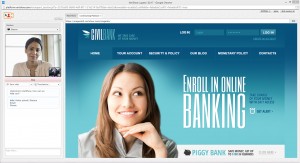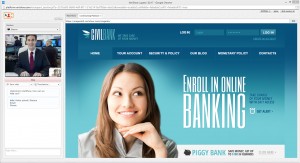Introduction to Co-browsing
Over the past year there has been a growing interest in adding co-browsing capabilities as a tool to help providing a better online customer service. Co-browsing in this context means browsing the very same web page together with another person.
Contrary to screen sharing functionality where the representative or the customer would be sharing their entire desktop, in the case of co-browsing, only activities within the browser are shared. That is a great benefit as it helps minimizing inadvertent exposure of private information by the party that shares their screen.
Today, there are various co-browsing technologies available. It is important to understand the differences between them in order to select the right technology and solution so the organization can maximize the return on such tool.
There are variety of elements and functionalities that have to be taken into consideration when making such decision. In the following paragraphs, we will elaborate on matters related to engagement flows as well as features that could be used in customer service sessions.
As in any interaction between two human beings, there needs to be a trigger to start an interaction. Interaction between a customer and a representative can begin in various manners. For example, a phone call, a textual chat, a video chat or an invitation to interact being send via e-mail.
When a need arises and the representative recognizes that co-browsing would be the best way to support a customer, the representative can launch that functionality. The customer needs to experience a seamless transition into the co-browsing mode, yet be aware of it and what it means, and have the option to stop such interaction. The agent needs to be familiar with the technology and be able to operate it effectively and in a friendly manner.
Co-browsing Technologies
As part of the activities that can take place within a co-browsing interactive session, a customer and a representative should be able to do several things. The tools should be used based on the particular need. In some occasions various technologies need to be used in parallel.
An agent (on the right) and a customer video chat and co-browse a website in real time using VeriShow
Co-browsing Offline Content: Pictures, Documents, Forms and Videos
A co-browsing solution should enable the sharing of information that may reside outside as well as inside a web site. It should let representatives and customers share documents, images, statements or other content in various formats including .DOC, PPT, JPEG, PDF etc. They should be able to upload, view and mark documents, view video clips together, fill-in forms, have them electronically signed, and use variety of tools such as calculators, along with being able to browse website pages in real-time.
The ability to work together within the browser on content that resides outside the web site could enrich an interactive session and help address a certain need for help, and therefore can be a great benefit as an additional tool.
Such capability is relevant in instances where there is a need to deal and work together on more personal and less general information. Flash or HTML-based technologies are used for such activities. There is a need for a platform to serve as a bridge between the two parties; there is a need for a set of tools to make notations and mark the content as well as the ability to save the marked content if needed.
The solution should also be working with mobile browsers given the growing popularity of using the web from mobile devices. Integration with communication activities such as phone, textual chat and video chat are needed to ensure best results.
Website Co-browsing Options: Proxy Co-browsing
When the focus of the cobrowsing activity is on browsing web sites together, there are different technologies available. Each has its advantages and disadvantages. One type of solution is known as a Proxy solution. In that solution the browser experience is shared on an additional server that resides between the two parties.
One type of proxy co-browser allows the synchronization of the views by sending webpage content images to the two parties. This has the advantage of being able to synch anything visual (including dynamic content such as SVG animations). It shares however the limitations of other proxy solutions described below.
As the two parties are actually viewing images, every action that is taken place (such as clicking on input field, scrolling, opening a dropdown) will take some time, and there would be a latency in seeing the response of those actions.
Although the parties can browse pages together, cookies cannot be saved from the session and be used after the session on the real site, and a co-browsing session cannot continue from where the customer was on (in cases where cookies were used) for example when customer was already logged in or has already added items to a shopping cart.
In addition, content seen by users of the proxy co-browser may not be relevant to them where for example it is location-based.
There are also several issues related to the security of the shared pages as the proxy server is another element residing between the two parties. Saying that, for general cobrowsing purposes where a customer may want to show a representative a competitive product or another service in a site not managed by the representative’s company such solution may be sufficient. In addition, proxy solutions do not require the addition of code to the co-browsed site and by that reduce deployment times.
With regard to mobile devices, there might be scaling issue in mobile, PC or other devices, because the actual surfing is done on a different machine with some resolution set into it.
Website Co-browsing Options: Direct Co-browsing
An alternative technology referred to here as ‘Direct Co-browsing’ is based on the principle that co-browsing can truly continue from where the customer is. This technology requires tagging each and every page of that site to allow for such co-browsing.
Although the set-up requires more work, that approach is more secure as there is no additional (Proxy) server between the representative and the customer. Furthermore, cookies will remain in browser so sessions that start following existing customer’s activity will be supported. These could be critical as for example, they could support co-browsing that can continue after the customer has logged in, added items to a cart, started a registration process or has a particular language settings.
In addition, at the end of the co-browsing session, customers can continue browsing on the real site, and browse or check out from the point the representative has left them.
In these scenarios, the site owner can bring up alerts that will require the customer authorization to permit co-browsing as the session becomes more in depth and may include personal information, which would address certain privacy and security aspects.
Summary
The best solution is one that can offer the variety of alternatives and is able to combine various technologies under a single umbrella that can allow the organization to use the right functionality at the right moment.
| Features | Proxy Co-Browser | Direct Co-Browser | Offline Content Co-Browser |
|---|---|---|---|
| Preserve cookies | Partial/limited | Full Support | N/A |
| Browse from last page the customer was in |
Depends if the user was logged in. |
Full Support | N/A |
| Preserve shopping cart | No | Full Support | N/A |
| Requires setup | Minimal | Requires minor setup and code insertion in the pages |
None or little (content upload) |
| Support user locale | None – Depends on the server geo-location |
Full Support | N/A |
| Browse other sites | Supported | Requires a browser extension |
N/A |
| Security | Can be problematic; all data is passed, through another server, if user logs-in within the co-browser the proxy server, in effect will log in and may be seen as security threat. |
All data remains at the original browser/user.No security threat. |
Depends on solution. |
| Browser compatibility | Full Support | Full Support | Full Support |
| Site analytics information |
The proxy co-browser will generate incorrect analytics’ information as it is taking place on third party server |
As the user is browsing from the same machine it will not generate false analytic information |
N/A |
| Share and work together on PDFs(inc. forms), images, videos |
Partial | Partial | Full Support |
| Synchronization of dynamic elements |
Some solutions fully support this with certain limitations (e.g performance) |
Partial, e.g some elements may be fully synced, some may only be viewed. |
N/A |



0 Comments
Leave A Comment